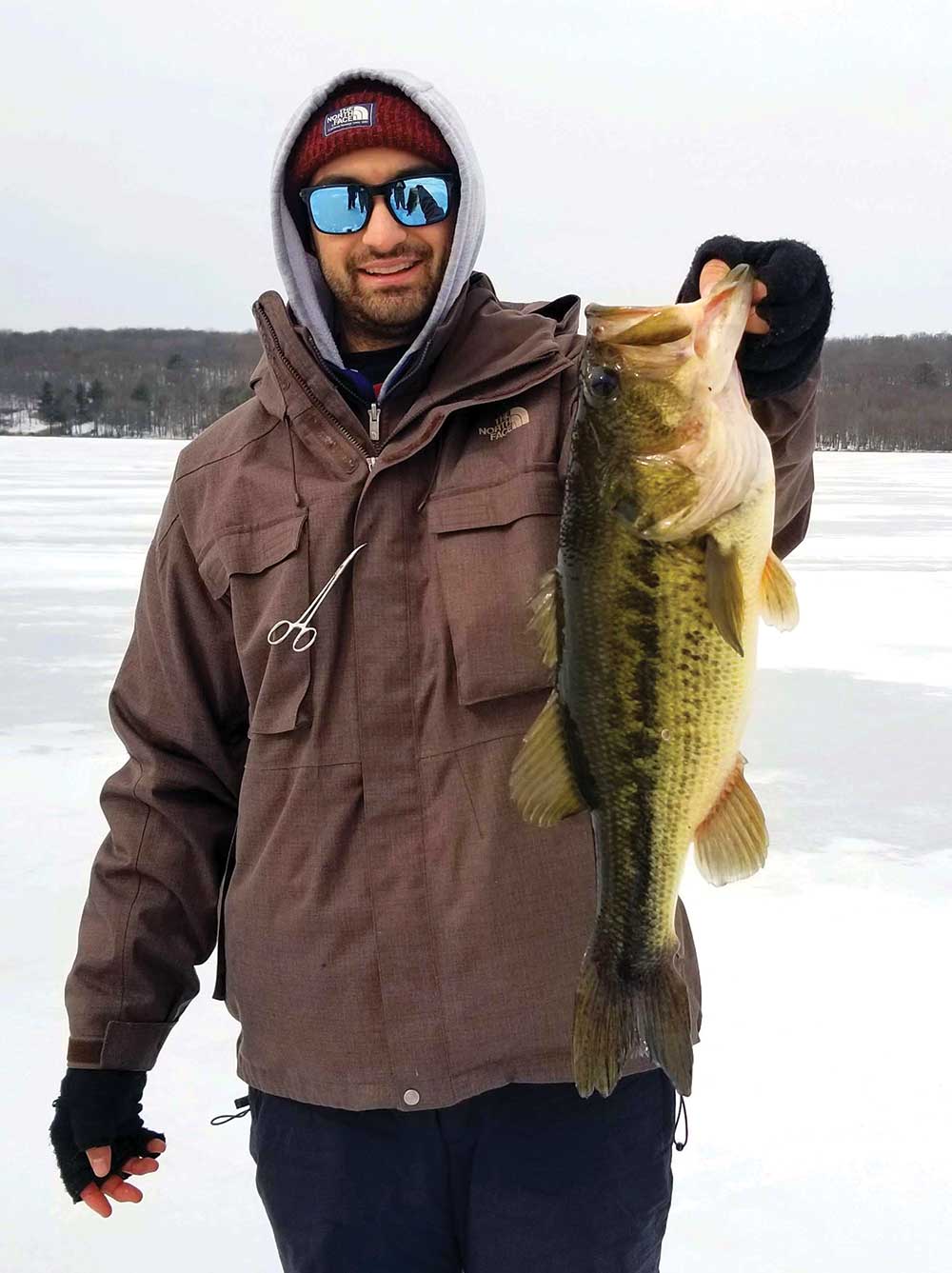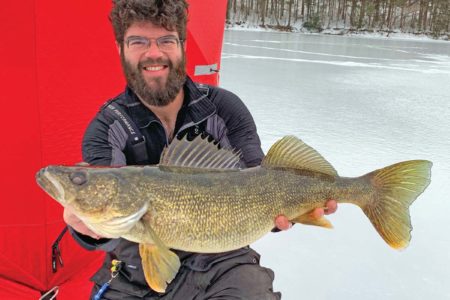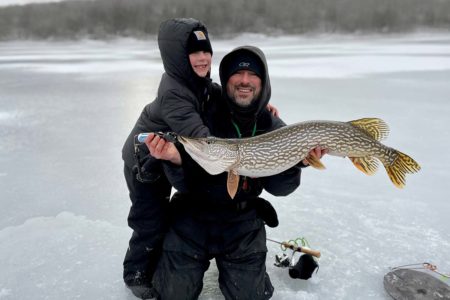Ice fishing can be a fun experience that just might change how you feel about winter.
As winter settles in, most boats are covered in shrink wrap, and fishing opportunities become extremely limited. There is another option as temperatures drop and ice thickens on Long Island’s lakes and ponds, and those within a couple of hour’s drive north of the Island. Ice fishing is an easy sport to get into and with a few safety tips and a few pieces of gear you can start drilling holes through the ice and catching fish. Safety is the key, and your first step is making sure the ice is thick enough. If you don’t have an experienced ice fishing buddy to go out with, check with a nearby tackle shop familiar with the area you plan on fishing. The general rule for ice fishing and walking on ice is a minimum of 4 inches of clear ice. Minnesota’s DNR offers lots of good advice on ice safety at https://www.dnr.state.mn.us/safety/ice/thickness.html.
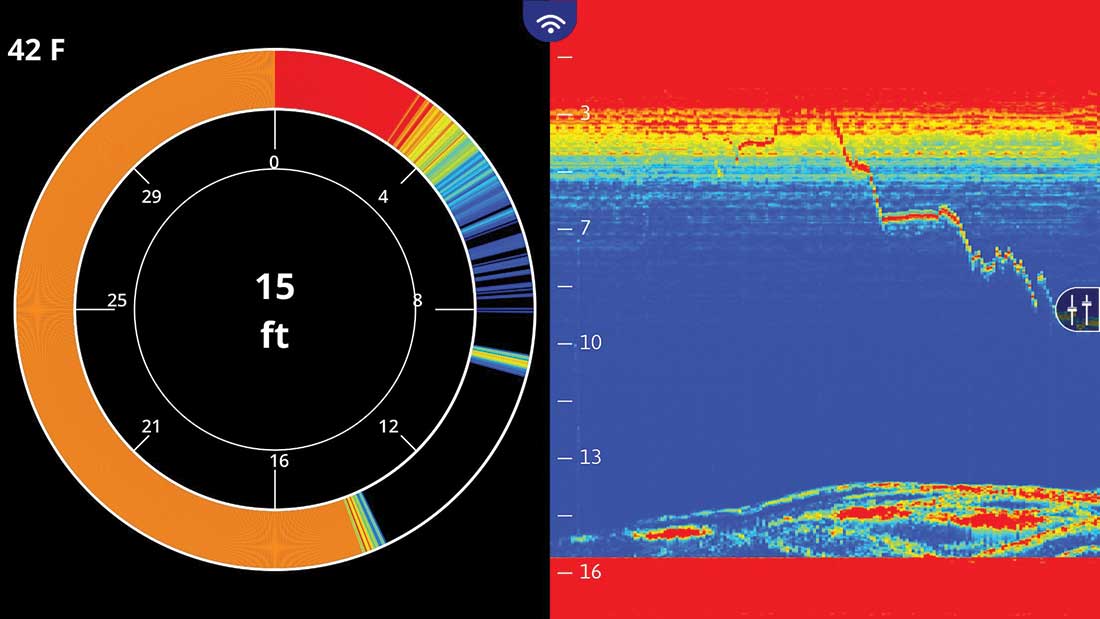
If you’ve never ice fished before, don’t knock it until you try it. It will most likely surprise you. Ice fishing is a great way to bend a rod during the long winter and after your first trip you’ll likely get hooked on it. The tackle is scaled down as most rods are in the 3-foot range, which leads to some great battles and sometimes, pulling drags. The most common species to encounter are panfish like bluegill and crappie, but yellow perch, trout, bass, pickerel and walleye are likely targets on some bodies of water. When the bite is on the fishing can be lock and load. Perch are especially fun to catch because they are aggressive and put up a good fight. Don’t let their relatively small size fool you. On the light tackle they can have your rod bent to the reel seat, and a good size largemouth will test your tackle and skill to the limit. You never really know what you’re going to pull through the ice and that makes it all the more fun.
You don’t need a lot of equipment to start ice fishing. First, you will need some kind of auger or drill attachment to cut the holes in the ice. Next is an ice fishing rod, which is relatively inexpensive. Most guys will take out a few different rods so they don’t have to re-tie, but just one will do to get you started. If you haven’t seen one before they are about 3 feet long and are paired with small 1000 sized reels with light line, generally in the 4-pound range. You can scale up or down depending on what species you will be targeting. You will need some artificial lures, like tungsten jigs, spoons, teardrop jigs, and jigging raps, all which can be baited with wax worms. If you are fishing in very cold temperatures, you will need an insulated bait puck to keep your worms from freezing. Safety spikes for your boots are important for traction, and it is important to dress for the weather. With these few things you can be well on your way to your new winter fishing addiction. Things like electronics and shelters are great to have but are not necessary to start ice fishing. You can buy more gear as you need it to make the experience more comfortable and successful.
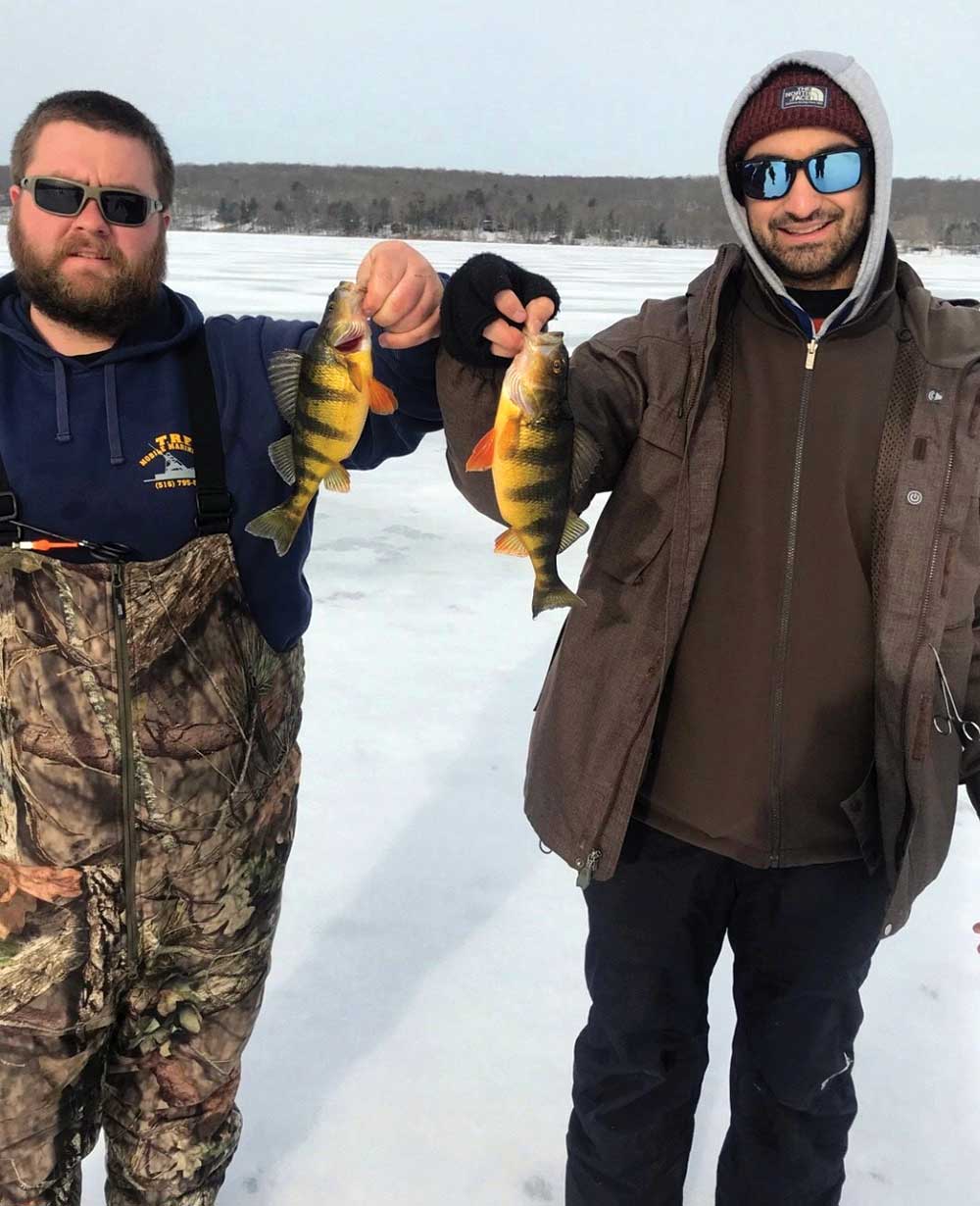
When looking for a place to fish, it is common to drill many holes in an area so anglers can bounce around to find the action. Once a good spot is found, a shelter can be put up to give you protection from the elements. You will be fishing right over your hole and vertically jigging your bait. Certain baits like jigging raps and spoons will glide a bit from side to side. Tungsten jigs will more or less stay vertical so you may need to impart a little different action depending on which bait you tie on. It is common to use a mobile sonar device or flasher in the hole where you are jigging. It will allow you to see the depth, and mark fish and bait on your screen. These mobile units, which are designed for ice fishing, have a transducer that floats in the hole and a small display screen. It can easily be moved from hole to hole when you are prospecting an area or looking for a certain depth. This is not necessary to catch fish, but it gives you a lot of great information. Many companies make entry level sounders that float in your hole and can be connected to your phone via Bluetooth and are only about the size of a softball. This will allow you to see the fish right on your phone or iPad! What really makes using electronics unique in ice fishing is that you can see the fish interacting with your bait on your screen. It’s like playing a video game. As you raise or drop your bait you can watch the fish follow.
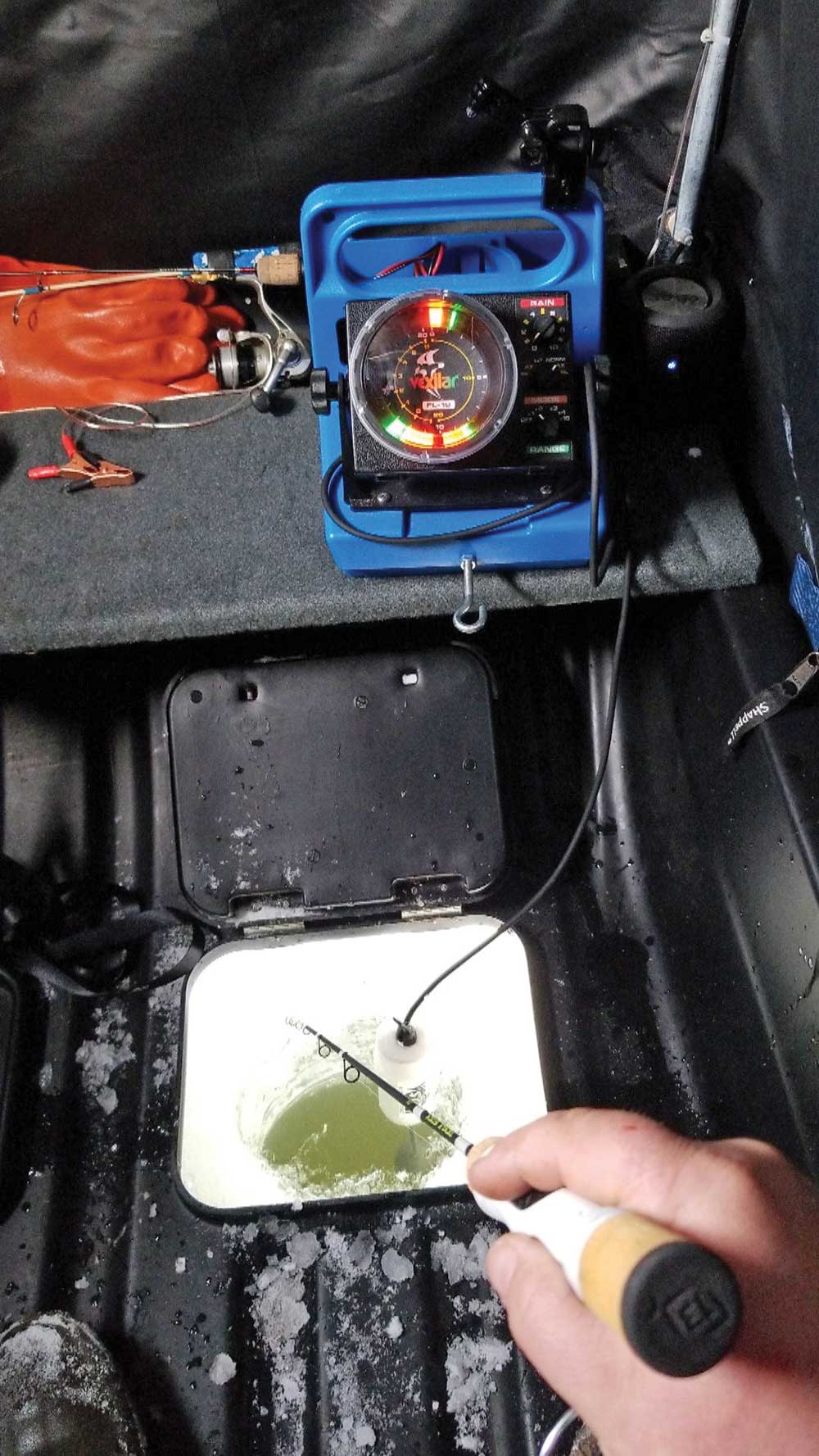
When using the flasher, the fish and your lure show up as lines. When you see lines (fish) appear, move your bait to that depth to entice them into biting. When the two lines meet, it usually means the fish is coming up to your lure and you can set the hook and start reeling. Sometimes you have to raise the bait above the fish to get them to eat it. Other times they want it staying relatively still with a slight jig – every day is different. It is important to vary your jigging pattern until you discover what is working that particular day. It is so much fun watching it all unfold on the screen and very exciting when your flasher finally shows a big mark coming for your bait.
To get more baits in the water, tip-ups can be set up in various holes in the area you are fishing. These are similar to dead stick rods but differ because there is no rod, just a reel and an indicator, which is the red flag. They are usually baited with live shiners or other baitfish. They are rigged up using leader material and are held down by split shots and a treble hook into the bait, two if it is a bigger bait. The flags allow you to monitor the tip-ups from a distance and many can be fished at the same time. This allows you to cover more ground and have more baits in the water. This way you can find out where the fish are staging. When a fish does eat the bait and pulls line the flag releases and raises up. This is when you would run over and see what is going on. If the line is going to the side or the line is pulling out, you likely have a fish on. You would then grab the line and set the hook and hand line the fish in. This is a fun way to catch the fish because you feel every head shake and run with the line in your fingers. If the fish is larger and wants to run, you have to be your own drag system and let it take some line. During the fight be careful to try and keep the slack line somewhat organized to keep it tangle free. This will make rebaiting a lot easier and quicker. Tip ups are an inexpensive way to get more baits in the water and catch more fish. Fishing live bait is often the ticket to enticing the larger fish in the lake or pond. Don’t be surprised to see more of the larger fish fall to your tip-ups.
Different lakes and ponds have different rules so be sure to check on these before you go fishing. To ensure the fisheries are sustainable many places require you to catch and release. Do not let this deter you as many of the fish won’t yield much of a meal anyway. Some places will not allow live baits to ensure that foreign species are not introduced into the ecosystem. Some will only allow artificials so it is best to check beforehand. As with any fishery, it is important to show the local guys on the lake or pond respect. A simple “Hello” goes a long way and could lead to friendships and shared information, which can cut your learning curve in half. Don’t let the winter keep you cooped up inside. Do your research to find some safe ice, drill some holes and bend a rod.
